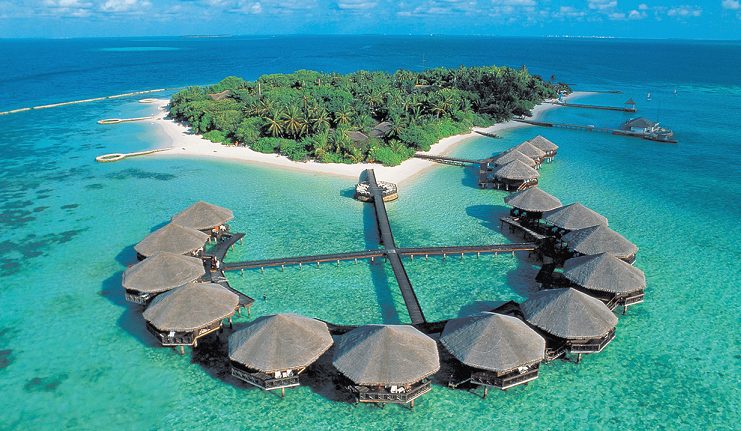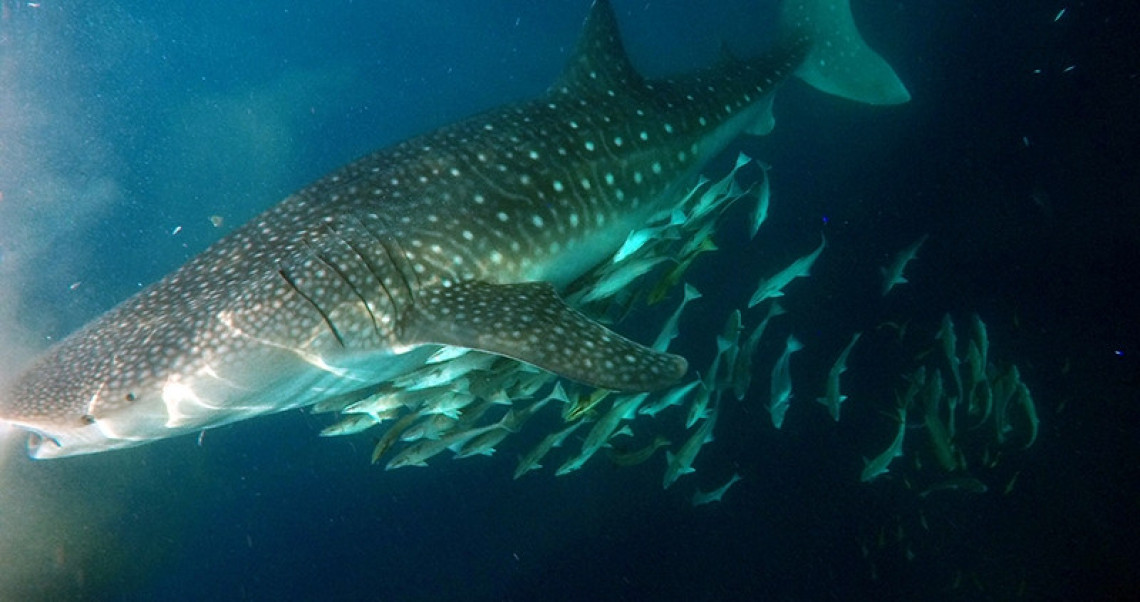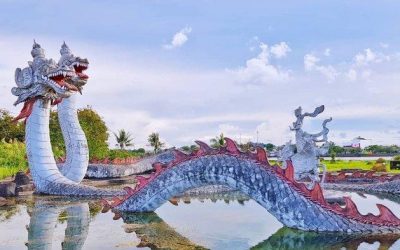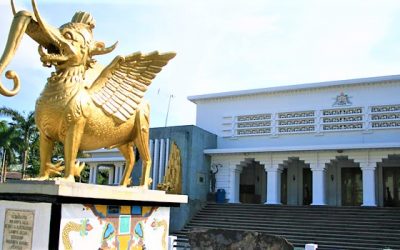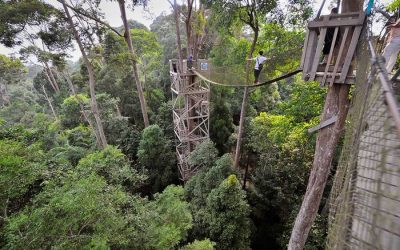Home / Batik Regions – Central Indonesia – Kalimantan Island – East Kalimantan / Derawan Island – Marine Conservation Site
Natural Destination
Experience the tropical nature!
Derawan Island – Marine Conservation Site
The Derawan Island in East Kalimantan (photo: @Kulibur)
Derawan Island
If you want to vacation in a tropical aquatic paradise and enjoy underwater biodiversity, visit Derawan Island, Berau Regency, East Kalimantan. It is a national marine conservation site where divers could see a number of wonderful marine animals such as whale sharks, dolphins, green turtles, yellow jellyfish, etc. The whale sharks are very close to the local fishermen. However, divers are suggested not to touch the protected whale sharks to respect its conservation. Visitors can enjoy the exotic white sand beaches here as well. In addition, Derawan Island also has beautiful resorts on the beach with typical Dayak architectural accents.
Natural Tourism Destination
Derawan Island – Marine Conservation Site
Tourist Attractions in East Kalimantan
Kumala Island of Mahakam River
Do you want to fully experience the Lembuswana mythology in Kutai?
Museum of Mulawarman
Do you want to explore Dayak culture across centuries? This museum offers
Bangkirai Hill Natural Conservation Site
If you have always dreamt to do a little adrenaline outdoor activities,
East Kalimantan
Batik Motifs
Tengkawang Ampiek
With its many advantages, the Dayaks use this leaf in ritual ceremonies. This plant is a symbol of
Hiu Taliyasan
Indonesia is also home to the world’s largest fish, the whale shark (Rhincodon typus). Hiu Taliyasan refers to
Kuntul Perak
Kuntul Perak refers to Egret Silver Bird. This bird is a Kalimantan endemic animal that becomes the
Discover
Indonesian
Batik
Motifs
Gigi Haruan Lidi
The Gigi Haruan Lidi motif is taken from the name of the cork fish and is a symbol of
Rangkiang
The word “Rangkiang” refers to the rice granary in the Minangkabau language. It symbolizes
Gamolan
This motif illustrates Gamolan, a bamboo musical instrument of Lampung that is
Cengkeh
The clove flower motif is the main commodity of the Tolitoli Regency. This motif represents
Salakanagara
Salakanagara batik motif illustrates the first kingdom in the Betawi land
Mahkota Siger
Siger is the crown of a noblewoman in ancient time. It is a symbol of femininity, strength, and
Buketan Bali
The Balinese bouquet (Buketan Bali) is a floral arrangement and the name is
Kawung
The Kawung motif was created by Sultan Agung Hanyokrokusumo (1593 – 1645) as a symbolic gift for
Prada Papua
The word “Prada” in the Javanese-Indonesian dialect means a batik textile that
Lipaq Sabe
Lipaq Saqbe contains a simple geometric classical motif with various flower decorations. This textile is
Bultiya
The word ‘Bultiya’ is an acronym of the three major tribes in North Kalimantan, namely
Leuit Sijimat
This motif reflects the daily activities of the Baduy tribe in Banten. The main ornaments of batik motif consist of:
Pohon Hayat (Tree of Life)
The Batik motifs in Lampung are dominated by the acculturation of Buddhist and
Besurek Rafflesia
The term “Basurek” refers to a textile that contains letters or inscriptions
Ikan tambal
The word “Ikan” refers to fish. The philosophical meaning of Ikan Tambal means is
Bintik Tujuh
The Bintik Tujuh (Seven Dots) motif has 7 white spots and green color gradation as
Daun Sirih
This motif illustrates betel leaves that are used by Lombok communities as traditional
Ake Patra
Ake is related to the divinity and the composition of the universe. It is a symbol of
Pala Salawaku
This motif illustrates the unique weapons of the Maluku region, namely
Daun Lada Hitam
The black pepper motif represents the main commodity of Bangka Belitung
Pattimura
Pattimura is the name of an Indonesian hero who fought against colonialism in
Kuda Kupang
Horses symbolize wealth. It contains noble values of virtuous characters that bring
Malinau Cultural Festival
You will witness a unique competition that might not be found other than in
Bekantan Pakis
This motif represents Pakis Haji (Polystichum setiferum), an endemic plant in
Rumah Mamuju
the Batik motif illustrates the house of Mamuju King with the stairs, located on the left of the wooden stage house
Dayak Taghol
Dayak Taghol has a distinctive style of four curved lines and small dots. This motif represents
Dayak Kamang
Kamang motif is generally found in the Dayak tribe shield because it is believed to
Karawo Pinang
Pinang refers to the Palm areca tree. This motif is considered as the original
Taiganja
Taiganja is a precious gold pendant that shows the social status of the Kaili family. It is
Pinawetengan
The Pinawetengan Batik pattern was taken from a prehistoric inscription in
Gorga Simeol-Meol
The Gorga Simeol-meol is a pattern of plant tendrils. it is regarded as a symbol of longevity and
Insang Ikan
Insang refers to the gills of the fish. This is a typical pattern of Malay ethnic who inhabits
Durian Pecah
Broken Durian motifs depict the foundation of faith. The second half signifies the mastery of
Gedhog Kembang Waluh
a combination of Javanese cultural motif of the Majapahit kingdom (XII-XIV century) with
Gumin Tambun
Based on Hindu mythology, this motif symbolizes lucks, abundant wealth, and
Honai
The Honai is inspired by the traditional house of the Papuan community living in
Tengkawang Ampiek
With its many advantages, the Dayaks use this leaf in ritual ceremonies. This plant is a symbol of
La Galigo
La Galigo is a literary work of the Buginese Epic that has 300 thousand epic lines. It is considered even
Gentala Arasy
Built as high as 80 meters, the tower also highlights the historical side of
Wakatobi
It symbolizes the coastal beauty of the Wakatobi island and the symbol of Patra symbolizes
Kain Cual
Cual textile tradition has existed since the 17th century. The word “Cual” refers to
Hiu Taliyasan
Indonesia is also home to the world’s largest fish, the whale shark (Rhincodon typus). Hiu Taliyasan refers to
Singayaksa
The Singayaksa motif comes from the name of a place where Sultan Hasanuddin used to
Tangerang Herang
Tangerang Herang motif is a symbol of Tangerang city. The Tangerang Herang batik motif consists of
Lok Baintan Floating Market
As you can imagine, the most authentic thing is that you can buy things and even
Sekar Jati
Sekar means flower and Jati refers to teak trees that symbolizes a strong mental character that
Gajah Way Kambas
The motif illustrates the Lampung’s natural reserve, the Way Kambas. it also symbolizes
Sekomandi
Its philosophical meaning is the eternal union which refers to a saying “until death do us part”
Tabir Tanjung
Tanjung flower is a type of Cherry tree flower, which is commonly found in
Tongkonan
Toraja’s traditional house is called Tongkonan. Tongkonan is a place for
Parang Rusak
Another meaning behind this motif is an unconquerable spirit, symbolized by
Tanah Liek
The word “Tanah Liek” refers to clay in Minang language. It is also known as
Gonggong Siput
Gonggong (Strombus Turturella) is one type of sea snail found around
Gonggong Beruntun
This motif illustrates that a person should maintain a positive attitude and
Burung Bidadari
Bidadari birds are endemic birds in Halmahera. This motif represents an
Srimanganti
The name of the Srimanganti motif is derived from Palace’s hallway that connects to
Bale Lumbu
This motif signifies the welfare of the ancient Sasak society. Bale also symbolizes the
Kaganga Tanah Rejang
If Batik Besurek combines Arabic calligraphy motifs, then the Kaganga batik takes
Jupri Kembang Teh
Kembang Teh illustrates the tendrils of tea plants that grow in the highlands of
Merak Ngeram
The hatching peacock motif has a very deep meaning which refers to the sacrifice and
Kaharingan
The Kaharingan or ‘tree of life’ based on the Dayak tribes’ belief system. This tree symbolizes
Ukir Sentani
The Ukir motif is a batik motif that is inspired by various traditional Sentani wood carvings
Desa Na Tolu
The Desa Na Tolu characteristic pattern symbolizes the Batak philosophy of existence and
Karawo Mahkuta
Mahkuta refers to Gorontalo’s traditional crown. It represents noble characters of
Tampuk Manggis Sasirangan
The motif illustrates the philosophy of the mangosteen fruit, which is
Biji Kopi
The coffee seeds motif illustrates the pride of local coffee specialities in
Angsa Duo
According to legend, the Angso duo batik motif is a pair of swans that are believed to have led Princess
Kerawang Tegak Aceh
The Vertical Upright (Kerawang Tegak) Motif symbolizes a person who has a strong
Teguh Bersatu
This batik motif shows the strength of the people of Kupang. It also represents a sense of
Pucuk Rebung Riau
Pucuk Rebung symbolizes heart determination in achieving goals, good luck, and
Tubo Kelapa
Coconut tree is a symbol of a good character and strong mentality. It illustrates the more success a person, the more
Kasih Tak Sampai
‘Kasih Tak Sampai’ is an idiom in the Indonesian language which refers to
Besurek Rembulan
This batik illustrates praise for God who created the wonderful universe
Enggang Dayak
Local people beliefs that hornbills are an incarnation of the Commander of the Birds. It has supernatural
Jumputan Bintang
The word Jumputan means the tie-dye technique, while the word “Bintang” refers to
Manguni Minahasa
Manguni is identified as the symbol of the Minahasa people. Manguni is known as a

